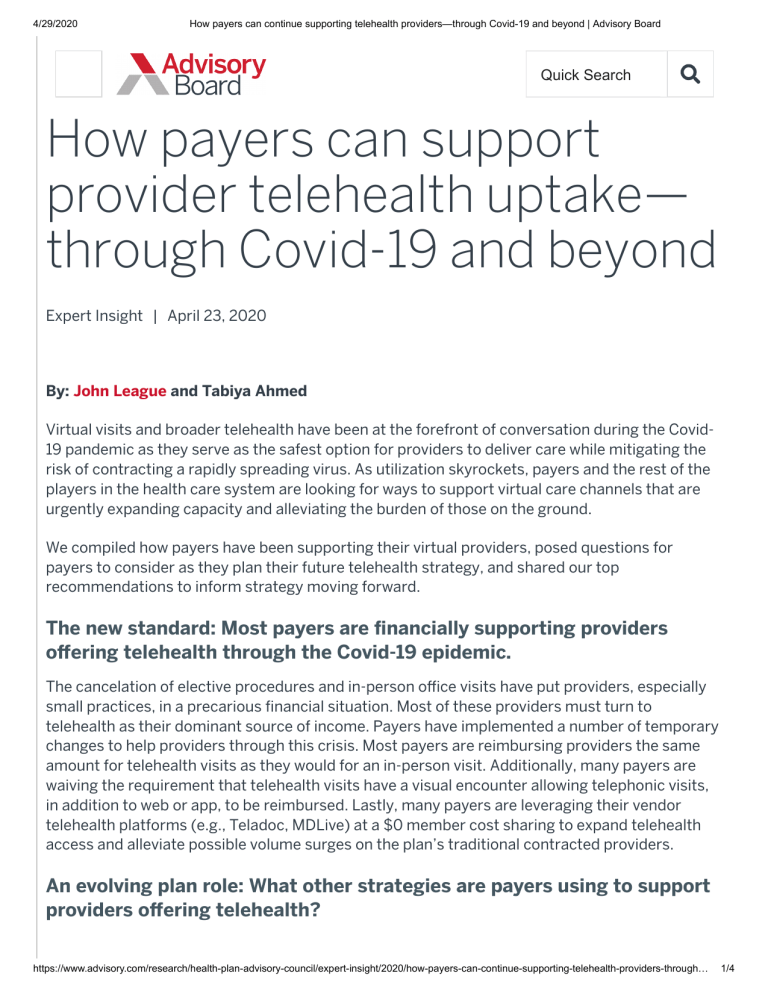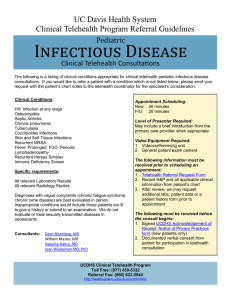
4/29/2020
How payers can continue supporting telehealth providers—through Covid-19 and beyond | Advisory Board
Quick Search
How payers can support
provider telehealth uptake—
through Covid-19 and beyond
Expert Insight | April 23, 2020
By: John League and Tabiya Ahmed
Virtual visits and broader telehealth have been at the forefront of conversation during the Covid19 pandemic as they serve as the safest option for providers to deliver care while mitigating the
risk of contracting a rapidly spreading virus. As utilization skyrockets, payers and the rest of the
players in the health care system are looking for ways to support virtual care channels that are
urgently expanding capacity and alleviating the burden of those on the ground.
We compiled how payers have been supporting their virtual providers, posed questions for
payers to consider as they plan their future telehealth strategy, and shared our top
recommendations to inform strategy moving forward.
The new standard: Most payers are financially supporting providers
offering telehealth through the Covid-19 epidemic.
The cancelation of elective procedures and in-person office visits have put providers, especially
small practices, in a precarious financial situation. Most of these providers must turn to
telehealth as their dominant source of income. Payers have implemented a number of temporary
changes to help providers through this crisis. Most payers are reimbursing providers the same
amount for telehealth visits as they would for an in-person visit. Additionally, many payers are
waiving the requirement that telehealth visits have a visual encounter allowing telephonic visits,
in addition to web or app, to be reimbursed. Lastly, many payers are leveraging their vendor
telehealth platforms (e.g., Teladoc, MDLive) at a $0 member cost sharing to expand telehealth
access and alleviate possible volume surges on the plan’s traditional contracted providers.
An evolving plan role: What other strategies are payers using to support
providers offering telehealth?
https://www.advisory.com/research/health-plan-advisory-council/expert-insight/2020/how-payers-can-continue-supporting-telehealth-providers-through…
1/4
4/29/2020
How payers can continue supporting telehealth providers—through Covid-19 and beyond | Advisory Board
Payers are finding innovative ways to mitigate the surge of clinical cases on providers by
undertaking unobtrusive forms of triage, participating in member education, and financially
supporting alternate sites of care.
a. MVP Health Care and Media Logic created the website,trytelemedicinefirst.com, which allows
anyone to search for a directory of telehealth providers by health insurance company name or
by zip code. This payer-agnostic tool shows telehealth offerings through a member’s health
plan or local hospitals and providers that offer telemedicine services based on the location
information that an individual enters.
b. Blue Shield of California launched a digital tool to assist its network hospitals in mitigating an
influx of consumers seeking advice about coronavirus. This tool can also divert the “worried
well” from unnecessarily utilizing telehealth by having everyone take an assessment that
advises them as to whether or not their symptoms are appropriate for a virtual visit or if they
should simply stay at home and monitor symptoms.
c. Medica announced it would allocate $100,000 to the Federally Qualified Health Center,
Washburn Center for Children, in order to advance their telehealth capabilities and meet the
urgent mental health needs for children with social, emotional and behavioral problems, and
their families.
Turning to the future: How payers can prepare for changes while
continuing to support their contracted providers
Payers continue to see growth in provider uptake in telehealth—the question is how much of this
utilization is out of current necessity versus sustained behavioral changes? While we anticipate
the exponential growth and interest to subside as Covid-19 progresses, the “new normal” will
most likely include greater comfort towards telehealth amongst providers and therefore a need
for a reformed telehealth strategy. Payers should consider the following questions and data
collection recommendations as they prepare for the coming changes.
Growth in provider uptake:
a. In what use cases will payers maintain reimbursement parity?
i. Reimbursement for all virtual visits at parity may not be possible for all payers due to
purchaser affordability implications. However, payers can determine which virtual visits are
equal or better as use cases. For example, a follow up in-person E&M visit is reimbursed
lower than an initial consultation but is still important for closing care gaps. Payers could
consider maintaining payment parity in use cases such as this where a timely, convenient
visit could save costs down the road. Other use cases that players could consider include
behavioral health visits, nutritional evaluations, or some prenatal consults.
b. What modalities of visits will still be reimbursed as telehealth?
i. While we anticipate that the regulation around reimbursement of “everyday” modes (e.g.,
phone call, FaceTime) of telehealth will return to being more restrictive, payers should
https://www.advisory.com/research/health-plan-advisory-council/expert-insight/2020/how-payers-can-continue-supporting-telehealth-providers-through…
2/4
4/29/2020
How payers can continue supporting telehealth providers—through Covid-19 and beyond | Advisory Board
consider partnering with providers to reimburse more cost-effective alternatives that bestfit provider needs while still meeting all HIPAA certifications.
Our recommendation: collect data on contracted provider telehealth
uptake
Providers have been “forced into the deep end” of telehealth usage. Gauging continued
provider interest and comfort with this technology through regular surveying will help prepare
for the shift in provider expectations and accommodate for a potential greater interest in this
form of care delivery in the future. Claims data from contracted providers billing for telehealth
will also highlight areas of high and low utilization and help payers design an ROI calculation
that can justify future plan design changes.
Reformed plan role:
a. How can payers integrate telehealth into appropriate care pathways?
i. Payers should still be involved in the referral process in order to manage capacity by
informing members while not being prohibitive and increasing administrative burdens. As
the urgent Covid-19 related demand for health care services decreases, it will still be
important for payers to embrace ways that they can use telehealth to either refer as a first
point of care or serve as an alternate site of care.
b. How can your vendor partnerships effectively supplement your network providers?
i. Providers need capacity to see their own members and coordinate ongoing care. Using
strategic vendor partnerships as a supplement to virtual visits post Covid-19, enables
traditional contracted providers to continue to see patients virtually while also alleviating
burdens during off-hours or for acute care needs and possible “worried well” patients.
Our recommendation: consider evaluating your vendor partnerships
Payers should evaluate the solutions they already have in place, including existing
relationships with vendors, providers, and other resources, like nurse lines and phone triage.
For example, while vendors can greatly supplement access during off-hours, Covid-19 has
revealed some limitations in the referral and follow up space which have reinforced the need
for payers to have a multipronged telehealth solution moving forward. Payers that are trying to
determine their telehealth strategy for the future need to start with an assessment of what
they already have on hand before they start buying, building, or renegotiating.
While most payers are in crisis mode and responding by generously covering most forms of
telehealth to get Covid-19 under control, it is expected that many of these policies, some of which
already have end dates, will roll back after the Covid-19 surge. The strategy that payers use to
implement these post-Covid-19 changes will be crucial in how telehealth is sustained by providers
moving forward.
https://www.advisory.com/research/health-plan-advisory-council/expert-insight/2020/how-payers-can-continue-supporting-telehealth-providers-through…
3/4
4/29/2020
How payers can continue supporting telehealth providers—through Covid-19 and beyond | Advisory Board
© 2020 Advisory Board. All rights reserved.
Privacy Policy
Legal Disclaimer
Terms of Use
https://www.advisory.com/research/health-plan-advisory-council/expert-insight/2020/how-payers-can-continue-supporting-telehealth-providers-through…
4/4





